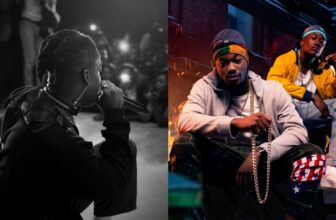What Is Grime Music? All You Need to Know

Grime music is a subgenre of electronic music that gained popularity in the UK two decades ago. It was influenced by multiple genres in the late 1990s, only evolving into a separate genre a few years later.
The genre is relatively new compared to other styles of music, but it managed to acquire a reasonable audience pretty quickly, specifically in the UK.
Contents
History of Grime Music
Grime music has its roots back to the early 2000s in London when artists popularized it through UK pirate radio stations like Rinse FM, Major FM, Deja Vu, Mission, and Delight FM.
In the 1990s, UK Garage skyrocketed in popularity, and while this style of music often incorporated R&B and soul influences, darker garage sounds appealed to a large number of listeners. These sounds emphasized instrumentation and focused less on vocals.
This is considered the turning point that helped grime music come to life. The combination of the dark garage sounds with the lyrical contribution of MCs led to the birth of grime music as we know it today.
The first-ever grime song is a matter of debate, with songs like Pay As U Go’s “Know We”, So Solid Crew’s “Dilemma”, Wiley’s “Eskimo”, and Youngstar’s “Pulse X” taking credits. The former two were released in the year 2000, while the latter ones were released in 2002.
Characteristics of Grime Music
One of the most prominent characteristics of Grime music is the fast beat. A large number of grime songs have a tempo of 140 BPM (Beats Per Minute).
Grime music is also associated with British culture and accent. Since this style of music originated in London, the British accent of the artists that cultivated its presence became an integral part of it.
The lyrics are often inspired by urban life, and the electronic sounds of grime music are usually more aggressive than other subgenres.
Other characteristics of grime include the heavy use of melodies and grunge-style bass lines.
Grime Music Subgenres
There are many sub-genres of Grime music, including Darkside, 8-bar, eskibeat, and sublow. These names were often used interchangeably to refer to grime music as a whole.
Darkside
Darkside is a subgenre that was first created by Terminator. It features a dark and aggressive nature with violent content.
Many said that this subgenre shares lots of similarities with road rap.
8-Bar
Grime music is defined by 4 beats to a bar in 8 or 16-bar cycles. The 8-bar subgenre emphasizes 8-bar cycles in favor of 16-bar.
In an 8-bar instrumental piece, the beat changes every 8 bars, and the MC raps to a different rhythm each time.
Nu Shape
In contrast to 8-bar, nu shape music use 16-32 bar patterns, making it very different from conventional grime music.
Eskibeat
As you might’ve guessed, the term “Eskibeat” is derived from Eskimo, hence the “Eski” part.
The term was often used to refer to grime music in general until the term “grime” was agreed on.
But how is it related to the Eskimo, anyway? Well, it’s all about Wiley’s thoughts in that period. He wanted to create a theme of anger and cold-heartedness, which matches the living conditions of the Eskimo.
Rhythm & Grime ‘R’n’G’
Just as it sounds like, the rhythm & grime or R’n’G fused grime with R&B (Rhythm & Blues) music. It’s generally softer than other forms of grime music. It also incorporates R&B vocals while preserving the genre’s fast-paced nature.
Ruff Sqwad, Skepta, and Wiley are among the artists that released R’n’G beats. The subgenre was also adopted by various R&B artists, like Lady Ny, Gemma Fox, and Katie Pearl.
Sublow
Sublow was one of the earliest names of grime that later evolved into a separate subgenre thanks to contributions from the Black Ops collective. It’s characterized by edge rhythms, deep low bass, and heavy synths.
Sinogrime
Sinogrime music borrows elements from East Asian culture with instruments and Kung Fu films samples. Some of the artists that pioneered this style of grime music include Wiley, Ruff Sqwad, DJ Wonder, and Geenus.
Notable Grime Artists
Here are some of the most popular grime artists that are credited for having the most significant impact on the genre’s development:
Skepta
Skepta is one of the oldest members of the Roll Deep crew. He was born in North London, and he later went on to form his own grime group, called Boy Better Know, in 2005. The crew released its first album in the same year.
It’s also worth noting that their 2016 Konnichiwa album earned a Mercury Prize, signaling the revival of the genre.
Wiley
Wiley is regarded by musicians and fans as one of the earliest grime music artists. His hit song “Wot Do U Call It?” is often considered one of the best grime songs of all time.
Wiley started releasing grime jams in the early 2000s, particularly in East London. He later formed his Roll Deep crew along with fellow grime artist Skepta.
Lethal Bizzle
Lethal Bizzle is a British rapper of Ghanian heritage. His music started gaining popularity in 2002 when his hit song “Oi!” made it to the top 10 singles chart in the UK.
His single “Pow!” (Forward) sparked controversy among music fans because of its aggressive lyrics, which led to the song being banned from clubs.
Stormzy
Stormzy is best recognized for making new songs with rap lyrics out of classic grime beats. One notable example is his “Shut Up” song.
His first album, Gang Signs and Prayers, managed to make it to the top spot on UK charts. It also helped him win the British Album of the Year award.
Ghetts
Ghetts gained worldwide popularity when he was a part of the NASTY crew. Later on, he created his own crew, “The Movement”, which also included rappers Wretch, Scorcher, Mercston, and Devlin.
This group managed to get a nomination for BET Award for Best International Act: UK
What’s the Difference Between Drill and Grime Music?
The biggest difference between drill and grime music is the tempo. Grime music almost always features beats with a tempo of 138-140 BPM, while drill songs often have a much slower tempo.
However, it’s not uncommon to find fast-paced drill pieces in the UK.
What’s the Difference between Grime and Rap?
The core distinction between grime and rap is the origin of each music genre. Grime music originated in the UK, while rap music first went mainstream in the United States.
Grime is heavily influenced by UK garage and jungle music, which makes it different from rap music. And while both genres incorporate hip-hop elements, they still differ in many aspects.
In grime music, the songs are strictly fast-paced and incorporate repetitive phrases and melodies. Rap pieces have a wider tempo scoop.
Summary
Grime music is a type of music that is originally from the UK and characterized by its fast-paced tempo and repetitive phrases. Although many grime artists made significant contributions to the development of this genre, the most popular among them are Wiley, Lethal Bizzle, Stormzy, and Ghetts.
Grime music is not to be confused with rap music since the latter originated in the US, while the former originated in the UK. Additionally, grime songs have a much faster tempo than your regular rap song.
It has grown in popularity in the US as well. And although it is a UK-born music genre, grime songs have been topping charts in the US lately.





